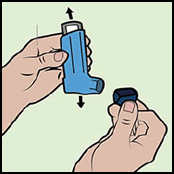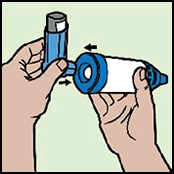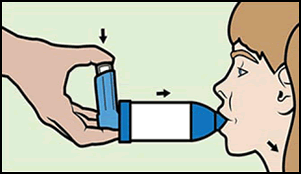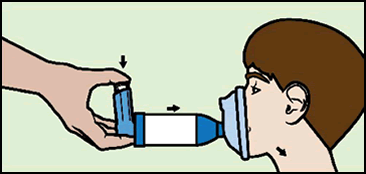What is a puffer?
A puffer (or inhaler) is used to treat wheezing symptoms (a high-pitched whistling sound when breathing in and out).
Puffers can be relievers (they relieve symptoms, making it easier to breathe) or preventers (they stop symptoms coming back).
What is a spacer?
A spacer is a cylinder-shaped device that connects to a puffer. Usually, you will take home the spacer (and mask, where needed) that your child used in hospital. You can buy spacers from your local pharmacy.
When to use a spacer
All children should use a spacer to inhale (breathe in) their puffer medication. A spacer reduces the amount of medicine that goes in your child’s mouth, so more of it can travel to the lungs.
If your child is short of breath and they do NOT have a spacer, medicine can still be given WITHOUT a spacer if necessary.
How to use a spacer
Step 1
Remove cap from puffer (and spacer if there is one). Hold puffer upright and shake well.

Step 2
Attach puffer to the end of spacer.

Step 3
Place mouthpiece of spacer in child’s mouth.
Step 4
Release one puff of medication into the spacer and ask your child to breathe in and out normally for 4 breaths.

Step 5
Shake the puffer and spacer between each dose. Repeat to give your child the number of doses as advised by your doctor. Replace cap on puffer when done.
When should I use a mask with a spacer?
If your child can’t seal the spacer with their lips, they should use a mask. The type of mask will vary depending on the size of the child’s face.
How to use a mask with a spacer
Step 1
Attach the mask to the mouthpiece of the spacer (with puffer attached).
Step 2
Gently place the mask over your child’s mouth and nose and make sure there are no gaps.

Step 3
Release one puff of medicine into the spacer. Hold spacer and mask in place while your child breathes in and out for 4 breaths.
Step 4
Shake the puffer and spacer between each dose. Repeat to give your child the number of doses needed. Replace cap on puffer when done.
Cleaning a spacer
Wash the spacer in warm, soapy water before the first use and every month after that. Do not rinse. Shake off any water and leave it to air dry. Do not dry the spacer with a cloth or paper towel. Your spacer should be changed every 12 months.
Developed by Emergency Department, Queensland Children’s Hospital. We acknowledge the input of consumers and carers.
Resource ID: FS092. Reviewed: July 2022.
Disclaimer: This information has been produced by healthcare professionals as a guideline only and is intended to support, not replace, discussion with your child’s doctor or healthcare professionals. Information is updated regularly, so please check you are referring to the most recent version. Seek medical advice, as appropriate, for concerns regarding your child’s health.